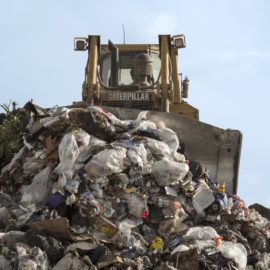
We have come a long way from this way of garbage pick up. This is not an environmental post but one of public interest. The mayor is renegotiating the garbage contracts and I am sure the price will go up.
When Mayor LaToya Cantrell’s administration rebids one of New Orleans’ two main trash-collection contracts in the coming weeks, it will mark the beginning of the end of a 15-year-old system that splits most of the city between two contractors hired to provide identical services for equal lengths of time. What, precisely, that will mean for residents is unclear; city officials declined to detail the scope of services in a request for proposals that is expected by mid-February. For the moment, residents outside the French Quarter and Downtown Development District will continue to be grouped into two similarly sized service areas, but the collection frequency and array of services could vary depending on where you live. “The new RFP will certainly be different in the way that it’s structured, in the services that we ask for,” Sanitation Director Matt Torri said. “You will have differences between the two service areas.”
nola.com
Differences? How can you have differences in such a basic service? 1 or 2 day pickup. Recycling. Large trash. I guess these are some.
Torri emphasized that recycling will return to Service Area 2, which covers Lakeview, Gentilly, New Orleans East and other downriver neighborhoods, once a new contractor is in place. Recycling had been on hiatus throughout the city since Hurricane Ida, but it resumed this month in Service Area 1, which covers Mid-City, Algiers, Uptown and other upriver neighborhoods. As for collection frequency, which was cut to once-weekly in both service areas after the hurricane, Torri said there will be no change in the foreseeable future for Service Area 1. But nothing will be decided in Service Area 2 until the administration reviews responses to its solicitation, Torri said. Since 2007, Richard’s Disposal and Metro Service Group have between them handled most of New Orleans’s solid waste collections, under nearly identical contracts that expire at the same time and require the same services, though price negotiations are handled individually. Richard’s has collected trash in Service Area 1, while Metro has patrolled Service Area 2.
Since I have Richards, I am in Section 2. I can live with 1 pick up a week but we have no kids at home. I want recycling. WHo set up these 2 systems as one contract should be cheaper.
Former Mayor Ray Nagin shaped that system, heralding the contracts – which together are worth between $20 million and $25 million annually – as the most lucrative in the city’s history for minority-owned firms. Nagin’s successor, Mitch Landrieu, renegotiated the contracts in 2016, resulting in seven-year terms, free recycling and a pay cut for Richards and Metro. With those contracts nearing their ends — and on the heels of a year in which service faltered or failed repeatedly — Cantrell has said she wants to overhaul the city’s trash collections altogether. Metro, in particular, has struggled to pick up the trash, and Cantrell has consistently said rebidding the Service Area 2 contract is the first step. But she has not sketched out a new vision for trash collection. However, she has said that service area lines could be redrawn or eliminated, that some collections could be brought in house and that new services such as composting could be offered.
Not sure how composting would work city wide.
One thing that isn’t likely to change any time soon: the $24 monthly sanitation fee on Sewerage & Water Board bills, which is uniformly applied across the city. That is already a sore point for many residents, some of whom feel the reduced services since Hurricane Ida should have prompted a corresponding break on the fee. That happened just once, in November, when the administration didn’t levy it. “This city is a ripoff,” said Demetrice Montgomery, while sitting in front of her house in the Seabrook neighborhood of New Orleans East on Thursday afternoon. “Why not at least make us feel confident, and give us a $5 discount?”
Ida did mess us up. No pick up for a while, then not on the regular schedule and then no recycling.
Trash collections that were already lagging due to labor shortages before the hurricane screeched to a near-halt for weeks afterward, causing rotting garbage bags to pile up across the city. The administration finally hired emergency contractors to help clear the putrid waste and return to consistent pickups — albeit on reduced schedules and without recycling. Torri said the $24 monthly fee is intended to pay for all sanitation department services, not just trash collection. When factoring in the cost of litter abatement, debris clearing, removal of illegal tires and other activities, the department’s expenses exceed its revenue, he said. In 2020, the most recent year for which complete information is available, the sanitation fee netted $34.5 million, about $2 million less than the department spent, according to S&WB documents and the city budget. The department’s 2022 budget is $41.6 million.
We did get Federal help and the emergency hiring of outside services cost more.
And although the Federal Emergency Management Agency agreed to cover one month of emergency operations to ease the crisis after Hurricane Ida – at a cost that exceeded $20 million – Torri said the city is continuing to pay more than $700,000 a month from its own coffers for temporary contracts just to keep collections stable. Keeping that going would cost more than $8 million a year. About one-third of that is going to IV Waste to provide supplemental collections in Service Area 2. The rest is paying for a privately operated transfer station in New Orleans East that had been shuttered since 2007. Waste Management’s agreement to reopen the station was critical to restoring service after the hurricane, officials have said. That is because the transfer station’s Chef Menteur Highway location offers a dramatically reduced turnaround time for full trucks to dump their loads and get back to the streets. Before it was open, haulers had to travel to the River Birch landfill in Waggaman, which in busy periods could mean a two or three-hour round trip after waiting in line. Under its agreement with the city, Waste Management receives New Orleans garbage at the transfer station and then completes the trip to the landfill. “I think we’re just very conscious of not doing anything haphazardly, that would jeopardize the reliable service that we’re having,” Torri said.
Reliable? That is what is needed so the schedule holds.
The focus on reliability is showing up in 311 data, which shows a tenfold decrease in complaints about missed pickups from November to December. But 311 doesn’t measure the level of satisfaction with once-weekly collections, especially with no adjustment to the sanitation fee. Weekly pickups are usually enough for Jasmine Jones and her wife, who live on Frenchmen Street in Gentilly. But residents at a fourplex down the street are routinely forced to place bags on the sides of trash carts, she said. “The cats get in it, then the wind is blowing it down the street and then we have to pick their trash up,” Jones said. Another Gentilly resident, Cornelius Celestine, said he and his girlfriend typically fill their cart without overtopping it, with exceptions for holidays and other busy times. While that is an improvement over the fall months, Celestine said he still finds himself stuffing five or six bags into a single cart. “When you’re accustomed to twice a week and you’re only getting once a week, you feel like, ‘OK, I’m only getting half the service,’” Celestine said.
We will hear more and hopefully the new contracts will work – until another big hurricane!



